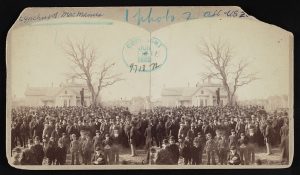Winner of the Fall 2017 StMU History Media Award for
Best Article in the Category of “Social History”
Rosa Parks, a strong, independent Civil Rights Activist, stood up for what she believed in. She’s known for her courageous acts dealing with the Montgomery Bus Boycott and the early phase of the Civil Rights Movement in the 1950s. But what happened in her life after these important events?
As we know, Rosa Parks was arrested for not giving up her seat on a Montgomery bus in 1955. She entered the bus, saw that it was quite crowded with one seat available located in the front “Whites Only” section of the bus. As more passengers boarded the bus, the bus driver demanded that he needed the seat Rosa was sitting in. She refused, and she was arrested.1

After her arrest on that December 1, 1955, Edgar Nixon, another Civil Rights Activist, paid her one-hundred-dollar bond. Immediately following her bail, she proceeded to file a lawsuit against the National City Lines bus company for its segregation practices. After weeks and weeks of this being an active case, the judges finally concluded. The court ruled bus segregation to be unconstitutional. The year-long Montgomery Bus Boycott finally came to a victorious end in Alabama in December 1956.2 During the boycott, Parks was invited by the United Auto Workers Union (UAW) to come to Detroit to speak to the union’s members. Local members of the UAW even raised the money to bring Rosa in. She stayed at the Garfield Hotel because blacks were not allowed to enter or reside at any downtown hotels. The mayor of the suburb of Dearborn had made his views on segregation clear: “Negroes can’t get in here. . . These people are so anti-colored, much more than you in Alabama.”3 Rosa Parks speech about the Montgomery boycott had a great impact on the UAW membership in Detroit.
Rosa Parks became an icon of the Civil Rights Movement. Her leadership skills and perseverance led to multiple doors opened for her, although at first she and her husband found getting employment difficult. In 1957, Rosa Parks moved to Detroit where her brother Sylvester lived. In 1964, Parks helped John Conyers campaign for Congressman, fighting for “jobs, justice, and peace” for Michigan’s first Congressional District. Certain laws prohibited some of Detroit’s residents from voting. Rosa was able to help Conyers win the election by obtaining the help of Martin Luther King. With King’s endorsement, Conyers won by a margin of 84%. Conyers then hired Rosa Parks as his secretary and receptionist, a position she held until 1988. Her daily tasks included dealing with issues such as, education, housing, and segregation.4

The Detroit that Rosa Parks moved to in 1957 was highly segregated. After World War II, Virginia Park, the historic district of Detroit where Parks lived, had become overcrowded, like many other sections of Detroit where African Americans were restricted. The district was further disrupted by the building of a highway, requiring the relocation of 43,000 citizens of Detroit, 70% of whom were African American. This led to increased frustration by Detroit’s African-American population, who were denied access to Detroit’s suburb housing, but told that Detroit was “colorblind” when it came to housing discrimination.5 When blacks attempted to move into the white suburban areas, realtors discouraged them and banks were very hesitant to make housing loans to them. If they succeeded, violence typically followed. By 1963, black citizens began to protest these closed housing practices. On June 23, 1963, Rosa Parks and Martin Luther King joined to lead Detroit’s Great March to Freedom to protest these unfair housing practices. This march drew a crowd over 200,000 people.6
Rosa also recognized that inner-city black students in Detroit, as elsewhere, didn’t receive the kind of preparation in their public schools to go to college. Growing up, Rosa herself barely had the opportunity to attend school, let alone college. With the assistance of Representative John Conyers, she raised government funds to open the Rosa L. Parks Scholarship Foundation. This Foundation gives Michigan high school seniors the opportunity to pursue a college education when they exemplify the ideals of demonstrating academic skills, community involvement, and economic need. This has been very beneficial for hundreds of students from poor Michigan communities since its founding in 1980. Although the process of creating this scholarship was very rigorous, Rosa was able to accomplish this goal.2
On October 24, 2005, Rosa Parks died from natural causes. She is still recognized to this day for her courageous acts.8
- Julie Bosman, Once A Stop for Rosa Parks (New York: The New York Times, 2016), 2-3. ↵
- Julie Bosman, Once A Stop for Rosa Parks (New York: The New York Times, 2016), 2-3. ↵
- Jeanne Theoharis, “The Northern promised Land that wasn’t: Rosa Parks and the Black Freedom struggle in Detroit,” OAH Magazine of History Vol. 26 No. 1 (2012): 23-24. ↵
- Jeanne Theoharis, “The Northern promised Land that wasn’t: Rosa Parks and the Black Freedom struggle in Detroit,” OAH Magazine of History Vol. 26 No. 1 (2012): 22-25. ↵
- Jeanne Theoharis, “The Northern promised Land that wasn’t: Rosa Parks and the Black Freedom struggle in Detroit,” OAH Magazine of History Vol. 26 No. 1 (2012): 24. ↵
- Jeanne Theoharis, “The Northern promised Land that wasn’t: Rosa Parks and the Black Freedom struggle in Detroit,” OAH Magazine of History Vol. 26 No. 1 (2012): 24. ↵
- Julie Bosman, Once A Stop for Rosa Parks (New York: The New York Times, 2016), 2-3. ↵
- Brinkley Douglas, Rosa Parks: A Penguin Life (New York: Penguin Books, 2000), 27-35. ↵



53 comments
Bictor Martinez
Rosa parks and her events at the bus will forever be remembered. The courageous Rosa Parks was able to end segregated buses by not giving in to what the white community wanted. She continued to make an impact in the black community through helping them receive jobs, scholarships, and justice. This article was very well written and able to showcase Rosa Park’s influence in the world.
Jasmine Rocha
We all knew Rosa Parks and her events on the bus that put her in jail but what I did not know were the events after that. When she got out of jail she helps towards the civil rights movement and was able to make segregation to be unconstitutional. The article highlighted many parts of Rosa Parks life after the events on the bus and how she has a place in history as a symbol and advocate of the civil rights movements.
Raymond Munoz
This article does bring up good highlights of Rosa Parks and does it very well, but it feels a little like a biography. I guess I get this impression because of the quick mention of how she passed. I believe a better closing could’ve been developed that highlighted the impact that the article started with. Though, other than this minor impression I felt this article was very informative of Rosa Parks and how she earned her place in history.
Ysenia Rodriguez
I commend you, Erik Shannon, for focusing on other aspects of this amazing woman’s life other than the same two sentence summary of how she was arrested for not giving up her seat located in the “Whites Only” section of the bus. Although this is a very important moment in Rosa Parks’ civil rights journey, it’s not her only deed. In fact, she did much more, and you did very well in covering the life and achievements of Rosa Parks. Well done.
Christopher Hohman
Nice article. I knew that Rosa Parks was famous for not giving up her seat on the bus, but I did not know how much she did after that. I did not know that she knew Martin Luther King. Two highly influential people in the civil rights movement right there. I also did not know that she had a scholarship fund in her name. What a way to give back to people. For her not to receive an education she must have realized that she even if she was not as well educated, that that did not mean that others could not be
Micaela Cruz
Rosa Parks was a true admirable role model; her decision to stand her ground and refuse to give up her seat created a huge movement, it was the action that started a revolution. Although the article didn’t provide a ton of background of Rosa Parks herself, it was a well-written and informative article that provided a deeper understanding of what all Rosa Parks was able to do and accomplish after her life-changing decision.
Michael Thomas
I found this article interesting and informative because of how it details the life of Rosa Parks during the Civil Rights era and her life after. Rosa Parks refusal to sit in the back of the bus made her into an icon of the Civil Rights movement because she won the lawsuit against the bus company. Overall, this article was good and well-written.
Noah Laing
The author did a good job of broadening the story of Rosa Parks and her activist actions. I certainly learned much more about Parks’ fasinating and inspiring life, which helped America take a closer step towards equality during that time. Parks’ mentality and determination could certainly be used still to this day, as unfortunatley, steps towars complete equality still need to be made. Great article.
Anna Guaderrama
I’ve always felt like Rosa Parks was an overall inspirational woman of color in history. I loved reading this article because of how informative and well written it was. Clear and concise, I really got a better insight of Rosa Parks. I always just knew her by the vague label of the woman that refused to give up her seat, but I feel like this article was written in such a way where I was opened up to a different kind of perspective with newer details.
Kimberly Simmons
When one thinks of Rosa Parks, the first thing that comes to mind is her bravery in refusing to give up her seat to a white man. This article further dives into the life of Parks both personally and as an activist. I was unaware of her political interest in Conyers, but it is clear that he played a large role in helping Parks, and many others, succeed. Her legacy continues to live on and her activism still speaks volumes!